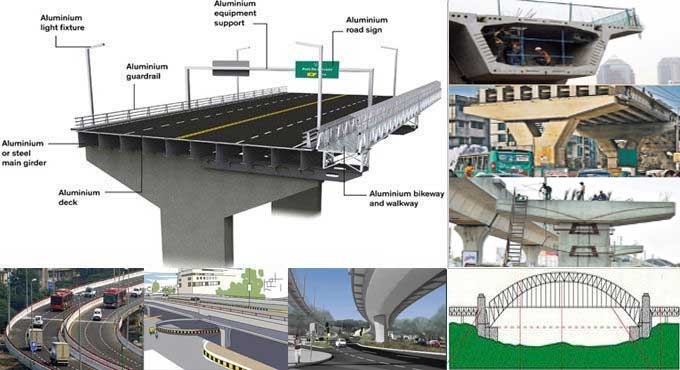
Choosing the Right Flyover Type: Design and Construction Guide
Overpasses and flyovers are high level road bridges that cross over an existing road or railroad crossing. Traffic can pass safely over obstacles below, preventing congestion below by using flyovers. There may be a need for a road, highway, or railroad to facilitate passage.
Flyovers connect railroads and roads by crossing them. Flyovers are also known as overpasses or highway bridges that cross highways or intersections.
Construction Process of Flyover
- In the first step, the alignment of the flyover is determined, as well as the piers and cleaning areas.
- Piles will be driven to the appropriate depth in many abutments or pillars.
- Leveling slabs or rat slabs may be present in shallow footing construction areas.
- On the lower part of the foundation, concrete is poured into the suspension, or the ground is poured, depending on how the foundation is constructed.
- Concrete pier columns or abutments are then erected after constructing the pier caps & abutments finish the work.
- After that, steel girders or precast girders & box girders can be placed.
- Next, either precast slabs of concrete would be used to build the deck.
- Once the railroad is built, the guardrail is installed, and the road markings are painted, you can begin building the roadway or railroad.
Flyover Types
Simple Flyover
There is a flyover spanning the high level, providing foundations in both directions, allowing fast traffic to pass over it and a short walk to cross under it. So, traders are exposed to two levels of risk, and therefore they lose out on gains.
Flyovers are still required as we have to continue to provide traffic lights at intersections under the flyover to allow people to approach from any angle.
Cloverleaf Flyover
Originally developed in America, cloverleaf junctions require a large amount of land and are also grade separators. It is avoided that there is conflict between traffic streams, so traffic can move at its own pace. There is no need to weave or slow down, which is a major advantage of this over a Simple Flyover.
Overpass Flyover
The definition of a flyover over a highway or railway is one built over an existing roadway or railway line that crosses a barrier. A flyover overpass serves the primary purpose of keeping other traffic away from the railway track.
Underpass Flyover
There are several types of flyovers underpass crossing railroad crossings, roads, and other obstacles. A flyover under an underpass allows cars and people to pass without disrupting a railroad or road. Traffic control is improved by both flyovers, resulting in a reduction in accident rates immediately.
Composite Flyover
Combined RCC and steel elements make up a composite flyover. Composite flyovers are strong because they combine both RCC and steel. For short spans up to 10 meters, rolled steel joists are used, and for longer spans, plate girders are used.
Steel Flyover
It is considered a steel flyover if steel is the primary material used for its structure. Compared with composite and concrete flyovers, this type is more cost effective.
Due to its steel construction, fluctuations in temperature might cause problems with expansions and contractions; therefore, it should be coated or galvanized.
Concrete Flyover
During the construction of concrete flyovers with steel, concrete is the main component. In addition to precast concrete flyovers, in-situ concrete flyovers can also be divided into cast in-situ concrete flyovers.
Flyover Merits & Demerits
Merits
There is less congestion in the roads, leading to a reduction in travel time. Safety for pedestrians & fast movement of emergency vehicles is improved.
Demerits
A built up environment is not suitable for them since they typically require a lot of space. Accidents are less likely, but the damage they cause will be substantial if they occur. Since the vehicle is at height, the chances of survival are lower in accidents. A construction of this type is extremely expensive.
To get more details, watch the following video tutorial.
Video Source: Civil Engineering


